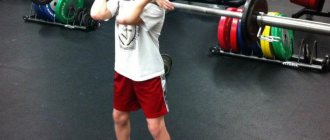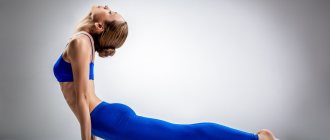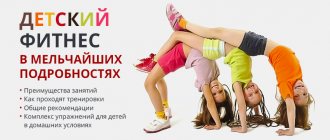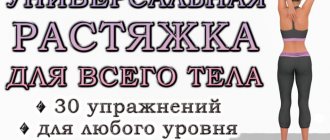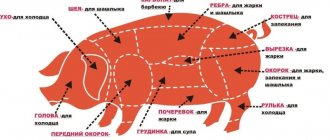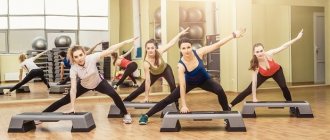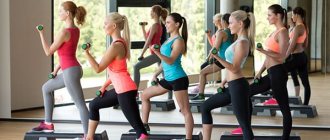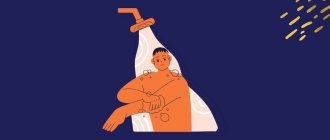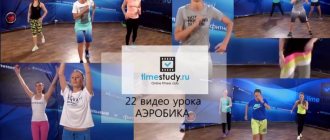Why aerobics is useful for children, what are the disadvantages, how much classes cost and how to choose a section - read in our article.
The word “aerobics” is on everyone’s lips. A complex of rhythmic movements accompanied by dance music immediately appears. Many people perceive aerobics as a sport for adults, aimed at combating excess weight, and which eliminates figure flaws. In fact, anyone can do aerobics, including children. A set of aerobic exercises is beneficial for a growing body: it strengthens posture; improves immunity, respiratory and cardiovascular systems; forms a healthy musculoskeletal system and improves coordination of movements.
From what age
Federal standard of sports training in sports aerobics. Appendix No. 1 - age of persons for enrollment in the stages of sports training.
Aerobics is suitable for both small children and school-age children and teenagers. You can start doing it at any age, starting from 1-1.5 years. Exercises will be selected depending on age characteristics. For young children, activities in the form of games are possible.
Conventionally, age groups can be divided as follows: children under 3 years old, preschool age and schoolchildren.
For the little ones, exercises should be simple: walking, squats. It is recommended to practice for no more than 10 minutes. For older children, the exercises may be more complex, including strength training and dance aerobics and lasting 20-30 minutes. You can add elements of yoga, step and exercises with objects, such as a ball or body bar.
Children usually do aerobics 1-2 times a week, older children - 2-3 times.
Assignment of sports categories and titles in sports aerobics.
Features and basic rules of aerobics for children
Special halls are equipped for classes, and children's rooms are set up. It is desirable to have:
- Swedish wall or children's sports complex;
- a dry pool filled with balls;
- rope, swings, soft modules, etc.
Children's club "World Class"
The basis of children's aerobics is basic aerobic steps, which are specially adapted for children. The exercise sets are designed in such a way that they take into account the age of the students, their development, characteristics, and interests.
Duration of classes
Experts say that children can perform exercises to music from the age of 1...1.5 years. The duration of classes varies for different age groups. Until the age of two, it is a maximum of 8...10 minutes, then it can be increased to 20 minutes. (up to 3 years). There are special techniques that make it possible for a child under 3 years of age and his mother to study together.
Medical contraindications
Aerobics has virtually no contraindications. You can choose any combination of exercises in accordance with the child’s health condition and enroll in a specialized group. For example, high-impact exercises will be contraindicated for children with respiratory diseases, but swimming or yoga will be beneficial. General contraindications include only serious diseases of the heart, respiratory system, trauma, disorders of the musculoskeletal system, exacerbation of chronic, viral or infectious diseases.
Medical examination of children: why, when and how often.
Aerobics kids project
Yulia Fedorova
Aerobics kids project
Project " Aerobics kids "
Fedorova Yulia Petrovna,
teacher of additional education in choreography
MBDOU D/s No. 39 “Chamomile”
GO "city of Yakutsk"
Project type : long-term.
Implementation timeframe: 2 years
Project participants : pupils of the senior, preparatory group (children 5-7 years old)
and teacher of additional education in choreography
Relevance and novelty of the project . Every year the number of children suffering from cardiovascular diseases, obesity, disorders of posture, speech, vision, coordination of movements, and respiratory function is growing. In this regard, the problem of finding effective ways to strengthen a child’s health, correct deficiencies in physical development, prevent diseases and increase physical activity as a powerful factor in a person’s intellectual and emotional development becomes relevant.
Recently, there has been a tendency towards the use of various means of physical culture with a health-improving focus. Aerobics plays an important role . It is aimed at improving the health of the practitioner’s body, restoring the joy of life and increasing functionality.
Based on this problem, I implemented a project for preschool children “ Aerobics kids ”
.
Object of study: health and educational process based on the topic of the project .
Subject of research: aerobics as a form of health-preserving environment for preschool educational institutions.
Aerobics is rhythmic gymnastics that combines elements of classical aerobics and various dance styles.
Dance aerobics is a set of exercises that are performed to musical accompaniment. This area of aerobics is not only one of the most effective, but also very interesting.
Direction of dance aerobics :
• development of children's creativity through musical movement;
• increasing the volume of physical activity of children during the day;
• developing communication skills in children in collective activities, team spirit, healthy lifestyle habits;
• developing children's skills for activities in different age groups;
• determining the place of children in the group by establishing their role, which requires special qualities;
• positive emotions from speaking in public.
The main goal “ Aerobics kids ” project
— strengthening the health of the child, preventing the most common childhood diseases and correcting existing deviations in health.
Project objectives :
• optimization of growth and development of the musculoskeletal system (formation of correct posture, prevention of flat feet)
;
• development and functional improvement of the respiratory, circulatory, cardiovascular, nervous systems of the body,
•improvement of psychomotor abilities: development of muscle strength, mobility in various joints (flexibility, endurance, speed, strength and coordination abilities.
• promoting the development of a sense of rhythm, ear for music, memory, attention, and the ability to coordinate movements with music;
• providing a beneficial effect of music on the psychosomatic sphere of the child;
• formation of skills of expressiveness, plasticity, grace and elegance of dance movements and dances;
• promoting the ability to develop emotional expression, emancipation and creativity in movement.
Project implementation stages .
Implementation of the project “ Aerobics kids ”
takes place in three stages:
Stage I (preparatory)
includes: setting a goal, studying methodological, popular science and fiction literature in this area, developing the content of the entire educational process based on the theme of
the project , organizing a developmental, educational and subject environment for the implementation of the project , selecting music for conducting classes.
Stage II (main)
.At this stage the following is carried out:
• development of an educational and thematic plan for the implementation of a project on working with children ;
• organized motor activity of children for the implementation of the project
At stage III (final)
held:
• Monitoring the achievement of planned results by children, formulating conclusions, planning further work;
• Participation in methodological associations and events at various levels;
• Creation of video material;
• Preparation of photo reports;
• Posting of project on educational websites
Expected results. As a result of the implementation of the project to introduce aerobics into the rhythmic system of preschool educational institutions, the problem of finding effective ways to improve the health and development of students, increase their level of physical fitness, and introduce them to a healthy lifestyle will be solved.
The main means of aerobics are :
— physical exercises of general developmental and special orientation without objects;
- general developmental and special physical exercises with objects (ball, gymnastic stick, hoop, etc.)
All of them are performed to musical accompaniment. The starting positions of such exercises can be: lying on your back, on your stomach, on your side; sitting with straight and bent legs; on the heels; in crouched positions, kneeling positions; standing, hanging.
General exercises include drill exercises, general developmental exercises for walking in place and moving, running, jumping, joint gymnastics exercises, stretching and relaxing muscles, and dance exercises.
Complexes of general physical exercises promote the development of muscle strength (form a “muscle corset”
, endurance, mobility in various joints and other motor abilities, that is, the problems of the general physical fitness of those involved are solved, and in connection with this, their physical development.
Specialized exercises include exercises for the formation and strengthening of posture, prevention of flat feet, breathing exercises, dance aerobics , and game stretching.
Complexes of specially targeted physical exercises promote the function or system of the body of those involved in which they are aimed. Most corrective and health-improving exercises are used here.
In the preparatory part, the initial organization of students is carried out, focusing their attention, setting their emotional and psychological mood. The tasks of functional preparation of the children’s body for the upcoming work in the main part of the lesson are solved. This is achieved with the help of drill exercises, special exercises for coordinating movements and music, various types of walking and running, musical games, general developmental exercises and other means that meet the objectives of this part of the lesson. In the process of performing various exercises, private health problems can also be solved.
The preparatory part, depending on the tasks assigned, takes 7-10 minutes of the total time.
The main part takes up most of the time and lasts 10 - 15 minutes. It solves problems of general and special orientation by means of dance, learns special correction exercises, improves the technique and style of their implementation, and works out the coordination of movements with music.
The work can use both sets of general developmental health-improving exercises, a series of dance exercises, and entire compositions, that is, groups of exercises united by a single semantic meaning and solving specific problems.
The structure of the main part may vary depending on:
- repeatability of exercises, alternating them in different starting positions (standing, sitting, supported, lying down,
— focus (on correction of the spine, foot, balance, coordination of movements, etc.)
- separate effects on muscles (arms, neck, legs, etc.)
.
Most of the physical activity occurs during the main part of the lesson, so it is very important to distribute it wisely.
In the final part, the problems of restoring the strength of the children’s body after physical activity are solved. It takes 5-7 minutes. The load here should be significantly reduced by reducing the number of exercises, their repetition, nature and motor actions. Such exercises include calm walking, exercises in stretching and relaxing muscles, both individual parts of the body and the entire body in a standing, sitting, lying or hanging position, elements of self-massage of those muscles to which a large load was directed, calm musical games or creative tasks, low-intensity dance movements or improvisation.
To successfully conduct classes, it is necessary to prepare in advance equipment and equipment, selection of musical material and equipment.
In dance aerobics you can use the following basic ones:
aerobics steps that adapt well to the specifics of performing exercises while sitting on a ball:
• March - march - steps in place, forward, backward, diagonally, etc.
• Step-touch - additional step to the right, left, forward, backward, with turns.
• Knee-up - lifting a bent leg, knee up.
• Lunge - lunge forward, to the side.
• Kick - throw the leg forward, straightening, leg forward, perform a swing.
• Jack (jumpingjack) - jumping legs apart and together, sitting on the ball.
• V-step—walking with legs apart and forward, legs together and back, and others.
Conclusion. aerobics classes can give good results. and most importantly, children and their parents like them.
Creating conditions of emotional comfort is one of the important tasks of the teacher, the development of not only the physical qualities of the child, but also the development of self-expression of each child.
By doing aerobics from childhood , a child acquires the skill to correctly perform exercises for all muscle groups, acquires a stable habit of systematically performing physical exercise, which in the future will preserve his health and lead to a healthy lifestyle.
References
1. Anisimova T. G., Savinova E. B. Physical development of children 5-7 years old. Volgograd, Teacher 2009
2. Bezrukikh M. M. Health-forming physical development. Motor project for children 5-6 years old . St. Petersburg, VLADOS, 2001.
3. Golitsina N. S. Non-traditional activities in kindergarten. M., Scriptorium, 2004.
4. Zimonina V. N. Raising a preschool child. Dewdrop. Growing up healthy. M., Vlados, 2004
5. Kashtanova G.V. .Mamaeva E.G., Therapeutic physical education and massage M., Arkti, 2007.
6. Morgunova O. N. Physical education and health work in preschool educational institutions. Voronezh.
PE Lakotsenin SS 2007
7. Morgunova O. N. Prevention of flat feet and posture disorders in preschool educational institutions. Voronezh, teacher, 2005
8. Mashukova Yu. M. Step gymnastics in kindergarten // Physical education instructor. 2009 No. 4.
9. Timofeeva, T. N. Cheerleading for preschoolers / T. N. Timofeeva, O. O. Tatarinova, M. V. Sokolova // Kindergarten: theory and practice. – 2011. – No. 10. – P. 68-75.
10. Utrobina K.K. Entertaining physical education in kindergarten for 5-7 years old. M. Gnome and D., 2003
Boys and girls
There is no gender division in aerobics. There is something for everyone here. Girls especially like rhythmic dance movements, and boys cope well with exercises that require endurance. It also happens the other way around. It all depends on the personality and physical capabilities of your child.
Dance aerobics develops body flexibility, a sense of rhythm, and strengthens muscles. Step aerobics is suitable for children of all ages. The exercises are performed using a special platform; for children it is small - up to 10 cm in height, on which various combinations of steps are performed. Children learn to maintain balance and navigate in space. Develops speed, strength and agility. Sports children's aerobics contains exercises that are found in gymnastics, but only those that do not contain complex acrobatic elements. You can engage in this type of exercise no earlier than 5 years. Sports aerobics develops flexibility, plasticity, strength and endurance. Children acquire correct posture and learn to control their body.
A set of aerobics exercises for children
There are many sets of exercises that are used in children's aerobics. One of them could be composed like this:
- stand straight, spread your feet shoulder-width apart; raise the right leg, bending it at the knee; The last one to touch is the elbow of the left hand; then raise the left leg and raise its knee until it touches the elbow of the right hand; the number of repetitions is at least 6 times;
- stand straight and spread your legs wide apart; the hands are placed at the waist (on the sides); transfer the body weight to the left leg, bend it slightly at the knee; the right leg touches the floor with its toe; go back and repeat everything in the other direction - transfer the weight to the right leg and beyond; number of repetitions – five in one direction;
- lie on your stomach on the floor, stretch your legs back, arms forward; lift both legs and arms up at the same time, hold for 2...5 seconds in the achieved position and lower to the floor; repeat everything about six times;
- stand straight, hands on your waist, legs to the sides, but not wide; squat on your toes while keeping your back straight; knees spread apart, arms extended forward; then they get up and squat again; and so on 6...8 r;
- stand straight, arms down, legs slightly apart; jump up, spread their legs even wider and lower themselves onto their feet; at the same time they clap their hands above their heads; with the second jump they return back; then perform the described movements at least five more times;
- pick up a gymnastic stick by its ends; stand up straight, hands with a stick below; they try to step over the stick with one foot, then back and repeat everything with the other foot;
- lie with their backs on the floor, legs bent at the knees, feet on the floor; arms are extended along the body; clasp your knees with your hands, raise your head and roll back and forth on your back.
Reviews from parents and athletes
Comment from the forum
When my 5-year-old daughter independently did the cross splits, I realized that it was time to send the child to a qualified coach in some section, otherwise her tricks would not bring her any good. The nearest sports school offered only sports aerobics. We went there, although before that I had never heard of such a sport. It turns out that this is a fairly new area of aerobics, but there is already a prospect of entering the program of the Olympic Games. There are strength exercises, stretching, and dance elements. The guys are really becoming very strong, both girls and boys! And yet it is a graceful sport. Good stretching makes children flexible, although not as much as in rhythmic gymnastics or acrobatics. This is a little different. Competitions are held in several categories: solo, couple, trio and group. So a child can bring several medals at once from one competition. A set of exercises with dance elements is performed to the music. They judge not only for technique and complexity, but also for artistry. If your child is training for results, that is, not just for himself, but also planning to take him to competitions, then be prepared for serious physical exertion. This is one of the least traumatic sports. But still, if you do not properly organize rest, nutrition and recovery procedures, then very soon the child will be squeezed like lemon both physically and emotionally. But how much pride and joy the results of their labor bring to the children! I saw adult sports aerobics athletes. The figures are wonderful! The girls are slender, graceful, without “pumping”, although they can do push-ups, etc., on their hands alone without support from their legs. And the young men, on the contrary, look very textured and courageous. What I mean is that the type of sport always leaves its mark on both appearance and demeanor. The choice is yours!
Shikhaleev Grigory, member of the Russian national sports aerobics team
— In a country that is crazy about hockey, boxing and MMA, what is it like to answer the question “What do you do” with the phrase “sports aerobics”? — Sometimes it’s even awkward to talk (laughs). And you try to say “aerobic gymnastics,” because most people don’t even imagine what it is. For them it’s just dancing, but in fact it’s serious physical activity, disappointment, and falls. This is a very difficult sport. — When friends and acquaintances see what your performance looks like, this tight jumpsuit and everything else, they don’t have a question: “What kind of garbage is this, why didn’t you go for a normal male look?” — Maybe this was the case before, but now, to be honest, the Russian team is mostly men. A normal masculine look.
Types of the most common and useful techniques
An integrated approach and format of conducting classes with an instructor or self-repetition helps you quickly navigate changing conditions.
To give lessons quality parameters, it is necessary to include in an effective program a sufficient number of techniques associated with complex effects:
Spatial orientation. During the lessons, a variety of exercises are used with a given direction of movement of the arms and legs, head and body. It is recommended to select basic programs where it is important to move forward and backward, right and left, crossing and simultaneously moving.
Temporary parameters of work. Rhythm and tempo allow you to take the perception of time periods to a new level and clearly respond to sound differentiation. During the training process, children have the opportunity to compare exercises by speed of reproduction and adjust the energy of repetitions.
Strength exercises. Steps and swings, jumping and running guarantee the strengthening of physiology and stabilize the functionality of internal systems. To avoid overwork, the programs are supplemented with unloading training to consolidate the material covered and the ability to neutralize psycho-emotional stress.
Exercises with sports equipment allow you to transform a complex even at a complex level into a playful and exciting process that is interesting to a child.
Children's aerobics classes form the basis for the subsequent activation of visual and auditory perception, through repetition and reproduction of the image seen, reaction to acceleration or deceleration of the musical tempo.
pros
The benefits of aerobics for children are enormous. With its help, you can accustom kids to an active lifestyle and distract them from the “street” or computers. At the same time, children improve their health, become stronger and communicate with like-minded peers.
Aerobics helps prevent diseases that come with a sedentary lifestyle, such as excess weight or heart problems.
Preschoolers are easily excitable, and sports such as aerobics help direct their activity and excessive energy in the right direction.
Aerobics trains self-control. Older children are ready to handle more complex exercises. Thanks to this, such important qualities as endurance, effort and determination develop.
In terms of health, aerobics covers all important areas of the body: strengthens the muscular, skeletal and musculoskeletal systems; improves joint function; trains the respiratory system; increases immunity; forms correct posture; prevents flat feet due to the work of the muscles of the lower leg and foot and stagnant processes in the body; optimizes metabolism; improves coordination of movements, strength and endurance to physical activity; increases activity and cheerfulness.
Another advantage of aerobics is that it can be done outdoors. Moderate exercise in the fresh air is doubly beneficial.
For school-age children, aerobics helps relieve mental stress after school.
The key to increased interest in children: the right music
Music chosen from the music library for dance or recreational children's aerobics is not just a sound track for walking in a circle or performing simple processes.
Music must necessarily correspond to a set of factors; they make it possible to control motor complexes and regulate the degree of load:
- rhythm. The appropriate rhythm of sound raises the emotional background of the training, stimulates physical activity and engages children in work;
- pace. Fast or slow music is suitable for different stages of program classes, where it is necessary to react with acceleration to the main movements and slow down at the end;
- pause. Musical breaks are required to stabilize the state of systems such as the circulatory and respiratory systems, ensuring a reduction in stress levels.
Sound differentiation stimulates creative development, ensuring habituation to the aesthetic component of the activity.
Experienced teachers and instructors recommend using music that is easily recognizable and combining it with classical and popular compositions, fashion trends and modern unfamiliar works.
On the development of sports in Russia
Matveeva Lyubov Karlovna - Chairman of the Sports Aerobics Federation of the Novosibirsk Region, coach of the Russian national team, head coach of the Novosibirsk Region sports aerobics team.
— As a result, what results did your training allow you to achieve this year? And what are your goals for the near future? — All our plans will depend on training events in January. All the leading athletes in Russia come there and the head coach conducts selections and forms team compositions. These are groups where there are dance gymnastics, a gymnastic platform - where there are six to eight people. We are looking at the guys who can show results. Our fate now depends on the head coach. Now there will be a number of preparatory events and minor starts before the Russian Championship. Because in addition to the head coach’s decision, it is important to take first place at the Russian Championship, which gives a ticket to the national team to participate in the World Championship. In sports aerobics it is necessary to constantly change the image in order to be unexpected. For the new season, we need to change something radically, not stand still. Then the judges start paying attention to you: “oh yes, this is something new, this is interesting.” But the most important thing is the elements, gymnastics. Execution is key. In 2022 the rules will change, where performance will be much more important than artistry. Source: Novosibirsk news nsknews.info
Preparation and warm-up
Active in terms of mobility, children's dance aerobics helps improve coordination and general orientation in space.
But it is necessary to start any lesson with a warm-up technique, which makes it possible to gradually activate the audience, interest them and stimulate interest in the tasks.
How to choose a section
Free aerobics classes in your city
Volgograd, Ekaterinburg, Ivanovo, Nefteyugansk, Omsk, PGT Izluchinsk, Perm, St. Petersburg, Surgut, Syzran, Tyumen, Ulyanovsk, Cheboksary, Yugorsk
Look on the Internet to see which fitness clubs or children's sports complexes located near your home offer aerobics classes. Read reviews, go to a trial lesson, talk to a coach or other parents. Under no circumstances force your child to study if he doesn’t want to or is tired. Classes should be fun. The important thing is to interest him and make playing sports an exciting event. Then the child will only benefit from sports.
Methodological and technical side of training
In kindergarten, at school or at home, children's, exciting aerobics to music should have a clear program, with exercises fully consistent with the age category.
The game format is reproduced through the use of equipment, such as step benches, fitballs of different diameters, balls and hula hoops, jump ropes and handles with ribbons.
Program training includes selection of exercise mode and intensity, which helps to optimally distribute the load and reduce fatigue
A well-designed training complex consists of several sequentially combined stages, differing in functional content and implemented tasks, applied techniques and combinations.
What must be taken into account when working with children?
Health-improving and dynamic adaptation programs help stimulate various factors of an internal and external nature, but when constructing lessons it is important to consider:
- functional and psychophysical stages of development of the audience attending group clubs and sections;
- features of group formation and the level of initial, natural motivation to reproduce the loads;
- combination of different exercises, compatibility of mobility and safety of using different equipment.
The collected and offered photos of children's aerobics allow you to visually assess the degree of children's involvement in the work process and their enjoyment of the activities.
Main part
After a short warm-up, the main training is carried out; experienced instructors recommend dividing it into two important sections, allowing you to comprehensively implement all physical activity:
- aerobic section. Involving the formation and support of a certain level of endurance, coordination and orientation in space;
- power training. When using sports equipment at this stage, you can diversify the monotonous repetition of the proposed techniques and simplify the process.
A comfortable and well-fitting children's aerobics suit does not restrict activity and allows you to clearly and correctly repeat visual images.
Justified need for the comprehensive development of the child
In all videos of aerobics in kindergarten, one can note not only the health-improving direction of the programs being developed, but also their creative focus.
Group activities allow you to actively realize the creative and physical abilities of the body, develop cognitive direction related to knowledge of your own body.
